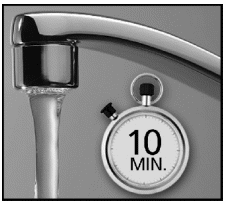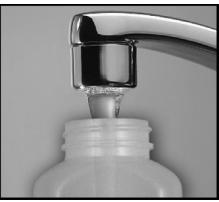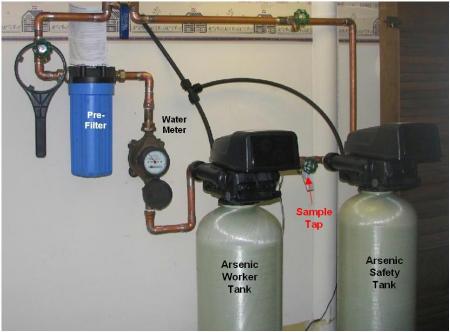Main menu
Frequently Asked Questions - Using and maintaining your arsenic treatment system
- Test the treated water one or two weeks after the installation is complete. This is very important. Even the best water treatment professionals can make a mistake and your system may not be working due to an error. DEP staff have seen homes with the wrong media in the tank (pH adjustment media instead of arsenic treatment media). Good installations have been observed to not remove any arsenic for an entire year because of incorrect settings on the bypass valves. Hence the importance of the initial after-installation test.
- After the initial testing shows the system is working, you should test the water at the kitchen sink and between the worker and the safety tanks (on a POE system) once every year.
- It is much harder for arsenic treatment systems to remove arsenic when the pH of the water is greater than 8.5, and at high pH the life of the arsenic treatment media is greatly reduced.
- In New Jersey wells with arsenic and a pH greater than 8.5, a pH adjustment tank should be included in their system. This can be accomplished by installing an anion exchange system before the arsenic tanks. The anion exchange system will reduce the pH about one point. The anion exchange system may also remove some arsenic which will also help increase the life expectancy of the arsenic treatment media, but as we note in FAQ 16 we strongly recommend against relying on an anion exchange system to remove arsenic.
- Well water with arsenic and pH greater than 9.5 is a more difficult situation that will require the attention and recommendation of your water treatment professional. Injection of ascorbic acid into the water before it goes into the arsenic tanks is one example of an approach for dealing with very high pH water.
- There are three main options for arsenic water testing:
- Lab Sampling - Lab Testing: The most convenient option is to schedule someone from the lab to come out and collect the samples for arsenic testing.
- Water Treatment Company Sampling - Lab Testing: Some water treatment professionals will provide annual testing as part of their service. Obtaining a service contract from them will take the worry away from you and protect your family's health.
- Homeowner Sampling - Lab Testing: You can pick up the appropriate bottles from a convenient lab, collect the water samples yourself, and deliver them to the lab.
- A list of certified labs capable of testing arsenic by the most sensitive analytical methods can be found on our "Testing Options" page.
- Sampling instructions:
- Stress the system: Run two cold water taps for at least ten minutes before collecting samples. This ensures the samples will not be from stale water inthe plumbing. See FAQ#24 for more details.


- Collect the between-the-tanks treated water sample:
- This is the most important sample to collect when you have a two-tank Whole House system. See the picture below for the location:

- Collect a sample of fully treated water at the kitchen sink:
- Remember to keep two taps running for at least ten minutes while collecting the water samples to ensure the system is stressed properly and you do not test stale water from the plumbing or treatment tanks.
- If arsenic is your only water quality problem, test for arsenic every year along with nitrates and total coliform which can change from year to year.
- You don't need to purchase the full Private Well Testing Act (PWTA) package every year, but testing for all PWTA contaminants once every five years is recommended.
- Yes, the treatment system needs to be stressed to be sure it works effectively when multiple taps are on at the same time.
- To test Whole-House POE systems, you should run two cold water taps full blast for at least 10 minutes before collecting the sample between the tanks or at the klitchen sink.
- The reason for stressing the system is that all treatment systems require contact time between the water and the treatment media to remove all the arsenic. The more taps that are on at the same time in the home, the faster the water goes through the tanks, and this shortens the contact time. You want to make sure the system is removing the arsenic during high water use times in the home (for example, two showers at one time, or a shower and the dishwasher or washing machine at the same time).
- Once per year you should test the water coming out of the kitchen tap.
- With a two-tank Point-of-Entry system you should also test the water between the two tanks once per year.
- You can add a yearly recurring event to your electronic calendar to remind you that it is time to test your water.
- You can pick a day of the year - maybe a holiday - and always schedule your water test for that day each year. One person picked Valentine's Day for their water test reminder day saying "My love for my family reminds me to make sure they're not being exposed to arsenic."
- No. Unfortunately the only way to tell if your arsenic treatment system is working is by a water test. Because arsenic is colorless, odorless and tasteless you would not be able to tell if it is breaking through the treatment system by looking at, tasting or smelling your water.
- All treatment systems require pre-treatment sediment filters to be changed on a regular basis. The timing of sediment filter changes depends on the specific characteristics of your well and water. If the water pressure in the home gradually drops, the first thing to look for is a clogged sediment filter.
- The post-treatment sediment filters will probaby only need to be changed once a year.
- Your treatment system installer should take care of the proper disposal of used treatment media.
- Used arsenic tanks shoud be tightly closed and disposed of.
- Treatment installers should never "re-bed" (empty the used media and replace with new media) in your home.
- Used media should not be touched with bare hands.

This work is licensed under a Creative Commons Attribution-NonCommercial 4.0 International License. | Contact us: Email


